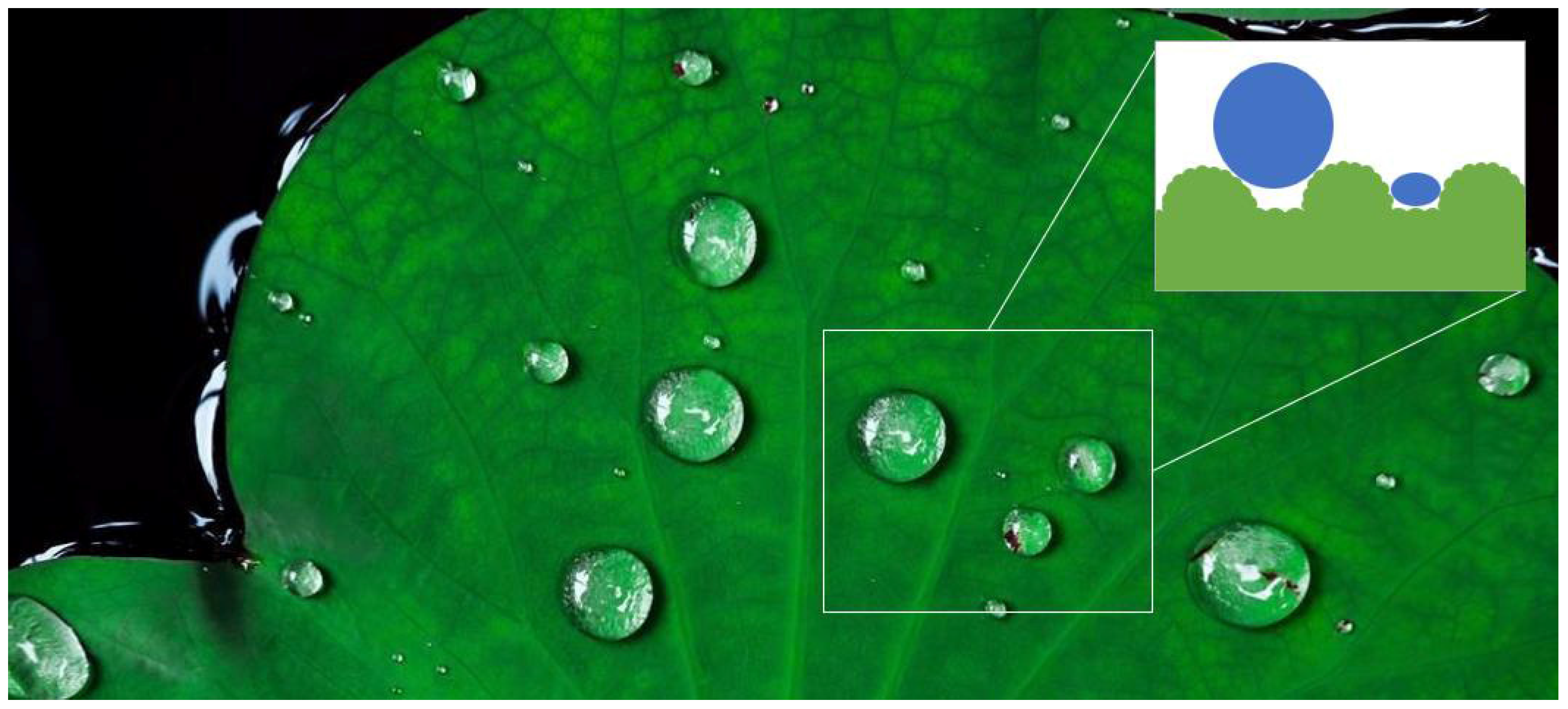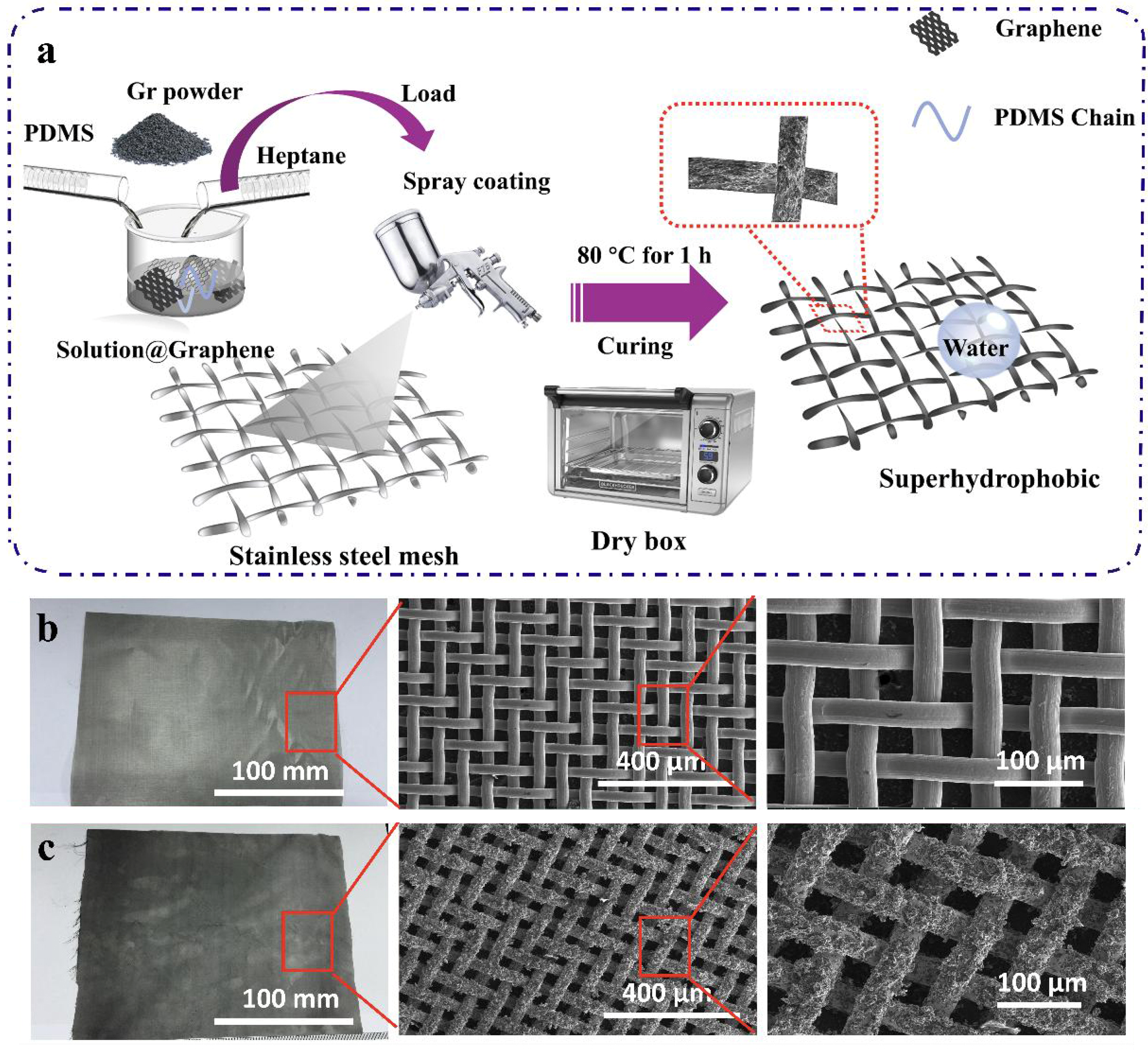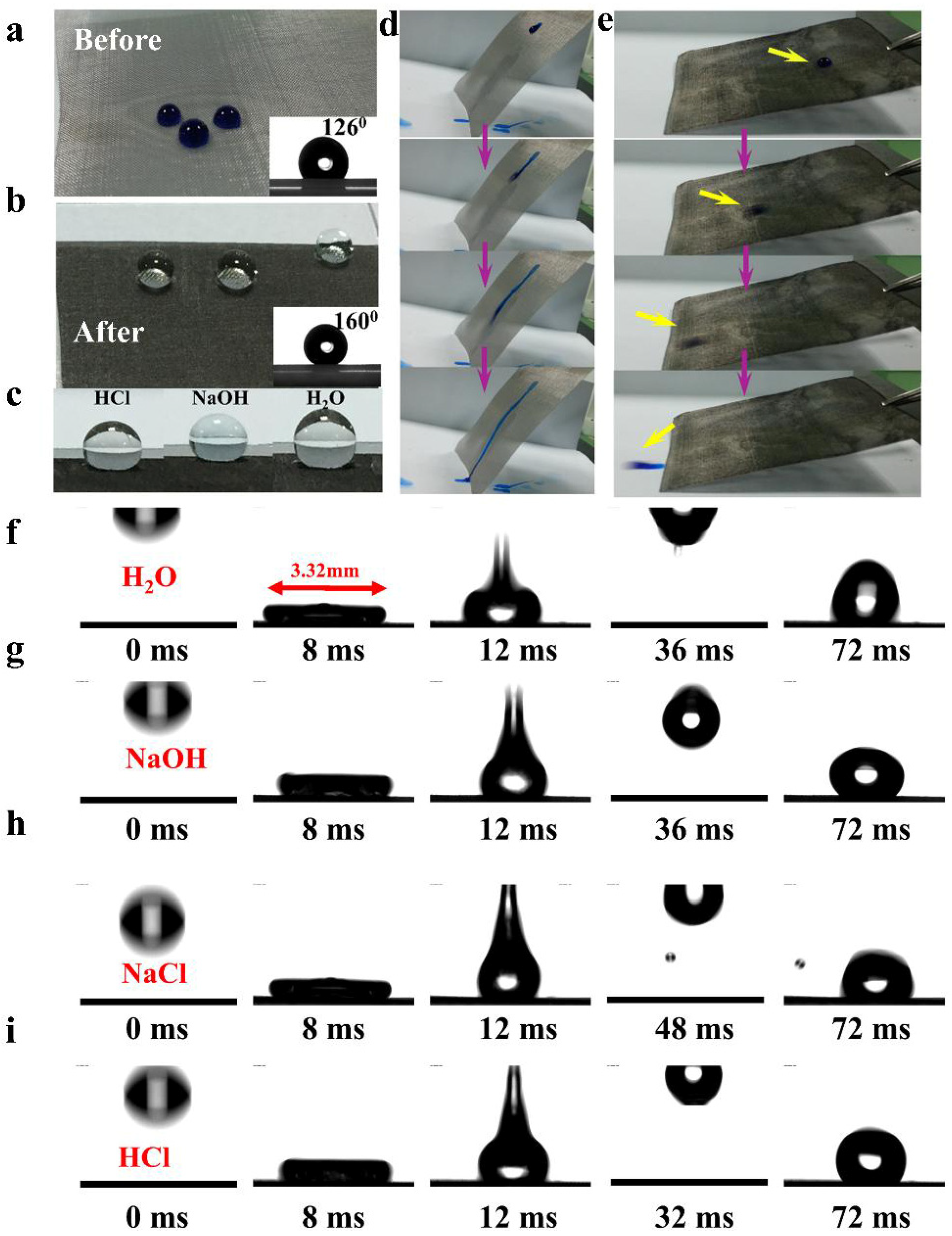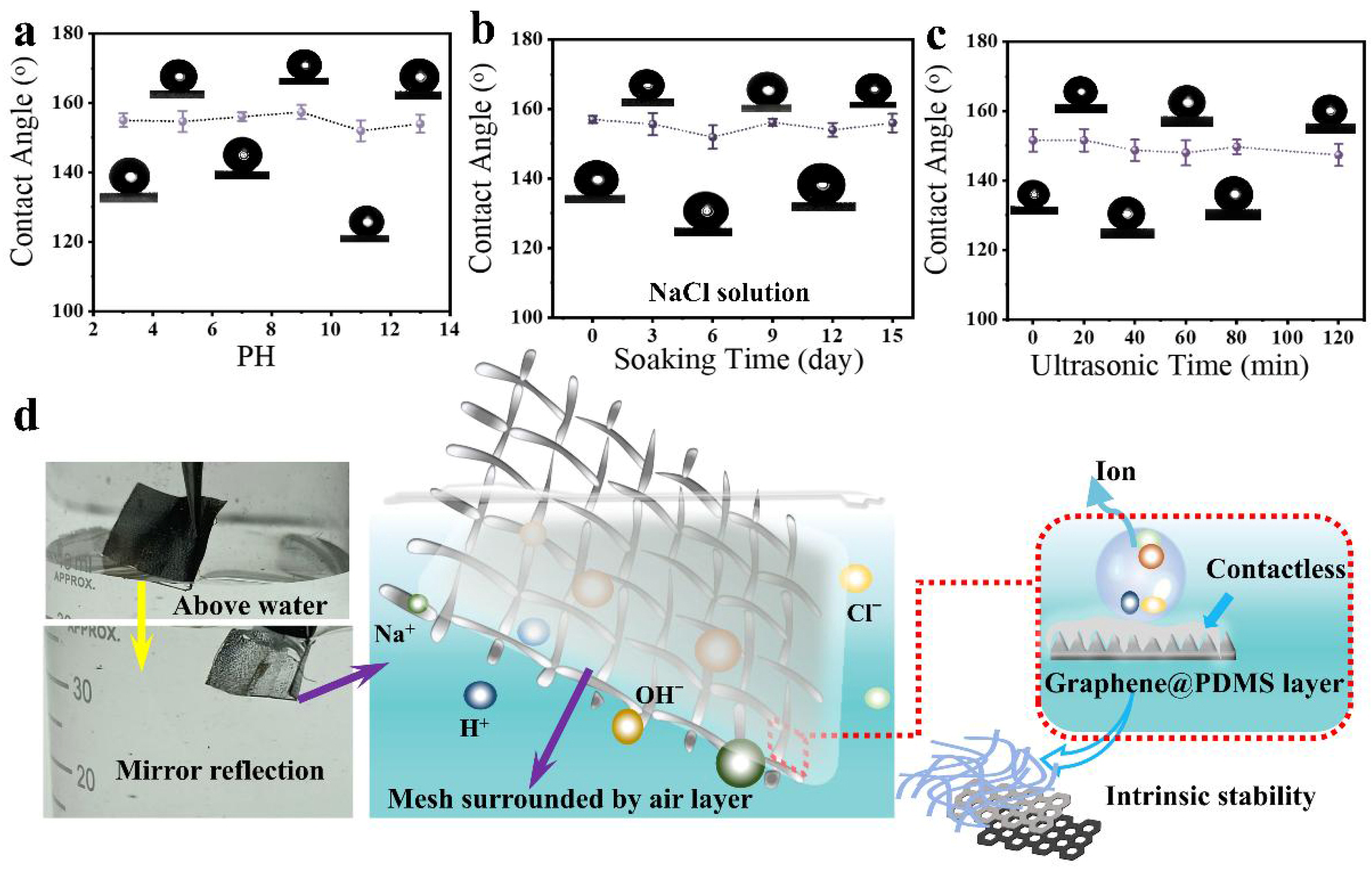Lotus Leaf-Inspired Corrosion-Resistant and Robust Superhydrophobic Coating for Oil–Water Separation
Abstract
1. Introduction
2. Materials and Methods
2.1. Preparation of GO and Graphene
2.2. Preparation of PDMS@Graphene Coating
2.3. Dynamic Droplet Adhesion Test and Oil/Water Separation
2.4. Coating Stability and Firmness Tests
2.5. Characterization
3. Results and Discussion
4. Conclusions
Supplementary Materials
Author Contributions
Funding
Institutional Review Board Statement
Informed Consent Statement
Data Availability Statement
Conflicts of Interest
Abbreviations
| SSM | Stainless Steel Mesh |
| PDMS | Polydimethylsiloxane |
| GO | Graphene Oxide |
| MSSM | Modified Stainless Steel Mesh |
| OSSM | Original Stainless Steel Mesh |
| SEM | Scanning Electron Microscope |
| CA | Contact Angle |
| SSS | Static Superhydrophobic Surface |
| CBS | Cassie–Baxter State |
| pH | Acidity or Alkalinity Scale |
| NaCl | Sodium Chloride |
| HCl | Hydrochloric Acid |
| NaOH | Sodium Hydroxide |
References
- Li, Y.; Han, M.; He, F. A review of treating oily wastewater. Arabian J. Chem. 2017, 10, S1913–S1922. [Google Scholar]
- Han, L.; Bi, H.; Huang, H.; Ye, M.; Sun, J.; Sun, L. Surface-engineered graphene-based multi-level filter materials for one-step separation of complex oil-in-water emulsions. Sep. Purif. Technol. 2024, 339, 126616. [Google Scholar] [CrossRef]
- Mullin, J.V.; Champ, M.A. Introduction/Overview to In Situ Burning of Oil Spills. Spill Sci. Technol. Bull. 2003, 8, 323–330. [Google Scholar] [CrossRef]
- Abidli, A.; Huang, Y.; Cherukupally, P.; Bilton, A.M.; Park, C.B. Novel separator skimmer for oil spill cleanup and oily wastewater treatment: From conceptual system design to the first pilot-scale prototype development. Environ. Technol. Innov. 2020, 18, 100598. [Google Scholar] [CrossRef]
- Marietou, A.; Schmidt, J.; Rasmussen, M.; Scoma, A.; Rysgaard, S.; Vergeynst, L. The effect of hydrostatic pressure on the activity and community composition of hydrocarbon-degrading bacteria in Arctic seawater. Appl. Environ. Microbiol. 2023, 89, e0098723. [Google Scholar] [CrossRef]
- Shahmirzaee, M.; Abdi, J.; Hemmati-Sarapardeh, A.; Schaffie, M.; Ranjbar, M.; Khataee, A. Metal-organic frameworks as advanced sorbents for oil/water separation. J. Mol. Liq. 2022, 363, 119900. [Google Scholar] [CrossRef]
- Huang, J.; Ran, X.; Sun, L.; Bi, H.; Wu, X. Recent advances in membrane technologies applied in oil–water separation. Discov. Nano 2024, 19, 66. [Google Scholar] [CrossRef]
- Sarbatly, R.; Chiam, C.-K. An Overview of Recent Progress in Nanofiber Membranes for Oily Wastewater Treatment. Nanomaterials 2022, 12, 2919. [Google Scholar] [CrossRef]
- Gao, D.; Xin, B.; Zhang, Z.; Wang, Y.; Yu, W.; Hou, C.; Jiang, Y.; Huang, P.; Xu, W. Study on the Preparation of Special Wettability Nanofiber Membranes and Its Application in Oil/water Separation. J. Phys. Conf. Ser. 2023, 2437, 012037. [Google Scholar] [CrossRef]
- Tanudjaja, H.J.; Hejase, C.A.; Tarabara, V.V.; Fane, A.G.; Chew, J.W. Membrane-based separation for oily wastewater: A practical perspective. Water Res. 2019, 156, 347–365. [Google Scholar] [CrossRef]
- Yang, K.; Zeng, X.; Xu, S.; Pi, P.; Wen, X. Opposite superwetting magnetic stainless-steel mesh for multiple types of oil/water separation. Mater. Res. Express 2019, 6, 105548. [Google Scholar] [CrossRef]
- Sharma, R.; Nath, P.C.; Mohanta, Y.K.; Bhunia, B.; Mishra, B.; Sharma, M.; Suri, S.; Bhaswant, M.; Nayak, P.K.; Sridhar, K. Recent advances in cellulose-based sustainable materials for wastewater treatment: An overview. Int. J. Biol. Macromol. 2024, 256, 128517. [Google Scholar] [CrossRef]
- Parvate, S.; Dixit, P.; Chattopadhyay, S. Superhydrophobic Surfaces: Insights from Theory and Experiment. J. Phys. Chem. B 2020, 124, 1323–1360. [Google Scholar] [CrossRef] [PubMed]
- Xu, Q.; Wang, X.; Xu, W.; Zhang, Y.; Xu, Z. Nanoparticle-free, Fluorine-free, and Robust Superhydrophobic Cotton Fabric Fabricated Using a Combination of Etching Method and Mist Polymerization Technology. Fibers Polym. 2022, 23, 1582–1594. [Google Scholar] [CrossRef]
- Cho, E.-C.; Chang-Jian, C.-W.; Chen, H.-C.; Chuang, K.-S.; Zheng, J.-H.; Hsiao, Y.-S.; Lee, K.-C.; Huang, J.-H. Robust multifunctional superhydrophobic coatings with enhanced water/oil separation, self-cleaning, anti-corrosion, and anti-biological adhesion. Chem. Eng. J. 2017, 314, 347–357. [Google Scholar] [CrossRef]
- Liu, S.M.; Liu, S.Q.; Wang, Q.; Zuo, Z.; Liang, X.D. Design and synthesis of robust superhydrophobic coating based on epoxy resin and polydimethylsiloxane interpenetrated polymer network. Prog. Org. Coatings 2023, 175, 107336. [Google Scholar] [CrossRef]
- Guo, X.J.; Huang, M.C.; Xue, C.H.; Wang, H.D.; Bai, Z.X.; Wu, Y.G.; Ma, C.Q.; Shao, Z.Y.; Jiang, Z.H.; Wan, L.; et al. Mechanically stable superhydrophobic coating of crosslinked polymer composite with self-healing ability. Chem. Eng. J. 2023, 480, 148035. [Google Scholar] [CrossRef]
- Das, S.; Kumar, S.; Samal, S.K.; Mohanty, S.; Nayak, S.K. A Review on Superhydrophobic Polymer Nanocoatings: Recent Development and Applications. Ind. Eng. Chem. Res. 2018, 57, 2727–2745. [Google Scholar] [CrossRef]
- Li, K.; Zeng, X.; Li, H.; Lai, X. Fabrication and characterization of stable superhydrophobic fluorinated-polyacrylate/silica hybrid coating. Appl. Surf. Sci. 2014, 298, 214–220. [Google Scholar] [CrossRef]
- Liu, Z.; Ren, L.; Jing, J.; Wang, C.; Liu, F.; Yuan, R.; Jiang, M.; Wang, H. Fabrication of robust superhydrophobic organic-inorganic hybrid coating through a novel two-step phase separation method. Prog Org Coat 2021, 157, 106320. [Google Scholar] [CrossRef]
- Wang, D.; Sun, Q.; Hokkanen, M.J.; Zhang, C.; Lin, F.-Y.; Liu, Q.; Zhu, S.-P.; Zhou, T.; Chang, Q.; He, B.; et al. Design of robust superhydrophobic surfaces. Nature 2020, 582, 55–59. [Google Scholar] [CrossRef] [PubMed]
- Zhang, H.; Sun, W.; Wang, L.; Wang, J.; Wang, S.; Liu, G. A Mechanically and Chemically Stable Superhydrophobic Coating for Preventing Marine Atmospheric Corrosion. Surf. Interfaces 2021, 27, 101537. [Google Scholar] [CrossRef]
- Barati Darband, G.; Aliofkhazraei, M.; Khorsand, S.; Sokhanvar, S.; Kaboli, A. Science and Engineering of Superhydrophobic Surfaces: Review of Corrosion Resistance, Chemical and Mechanical Stability. Arab. J. Chem. 2020, 13, 1763–1802. [Google Scholar] [CrossRef]
- Dong, K.; Bian, L.; Liu, Y.; Guan, Z. Superhydrophobic coating based on organic/inorganic double component adhesive and functionalized nanoparticles with good durability and anti-corrosion for protection of galvanized steel. Colloids Surf. A 2022, 640, 128360. [Google Scholar] [CrossRef]
- Hashjin, R.R.; Ranjbar, Z.; Yari, H.; Momen, G. Tuning up sol-gel process to achieve highly durable superhydrophobic coating. Surf. Interfaces 2022, 33, 102282. [Google Scholar] [CrossRef]
- Ju, G.N.; Zhou, L.; Li, J.; Su, C.Z.; Zhang, L.N. Robust metallic-based superhydrophobic composite with rigid micro-skeleton structure for anti-icing/frosting. J. Mater. Process. Technol. 2023, 316, 117916. [Google Scholar] [CrossRef]
- Wei, J.F.; Li, B.C.; Tian, N.; Zhang, J.J.; Liang, W.D.; Zhang, J.P. Scalable robust superamphiphobic coatings enabled by self-similar structure, protective micro-skeleton, and adhesive for practical anti-icing of high-voltage transmission tower. Adv. Funct. Mater. 2022, 32, 2206014. [Google Scholar] [CrossRef]
- Du, J.C.; Zhang, C.Y.; Pu, H.; Li, Y.F.; Jin, S.M.; Tan, L.X.; Zhou, C.L.; Dong, L.C. HKUST-1 MOFs decorated 3D copper foam with superhydrophobicity/superoleophilicity for durable oil/water separation. Colloids Surf. A Physicochem. Eng. Asp. 2019, 573, 222–229. [Google Scholar] [CrossRef]
- Vestince, M.; Ndayiragije, E.; Sammani, T.; Taj, S.; Mbuta, E.; Khan, A. Graphene synthesis, characterization and its applications: A review. Results Chem. 2021, 3, 100163. [Google Scholar]
- Jamsaz, A.; Goharshadi, E.K.; Barras, A.; Ifires, M.; Szunerits, S. Magnetically driven superhydrophobic/superoleophilic graphene-based polyurethane sponge for highly efficient oil/water separation and demulsification. Sep. Purif. Technol. 2021, 274, 118931. [Google Scholar] [CrossRef]
- Fan, T.T.; Su, Y.; Fan, Q.; Li, Z.H.; Cui, W.Y.; Yu, M.; Ning, X.; Ramakrishna, S.; Long, Y.Z. Robust Graphene@PPS Fibrous Membrane for Harsh Environmental Oil/Water Separation and All-Weather Cleanup of Crude Oil Spill by Joule Heat and Photothermal Effect. ACS Appl. Mater. Interfaces 2021, 13, 19377–19386. [Google Scholar] [CrossRef]
- Jiang, H.; Zhu, J.D.; Ge, S.Z.; Jiang, C.W.; Guo, T.Y.; Peng, T.P.; Huang, T.; Xie, L. Biocompatible, hydrophobic and resilience graphene/chitosan composite aerogel for efficient oil−water separation. Surf. Coat. Technol. 2020, 385, 125361. [Google Scholar]
- Zhu, Y.; Liao, Y.L.; Wang, M.; Dai, J.X.; Lei, C.S.; Liu, X.B.; Mu, P.Y.; Li, W.J.; Zhang, H. Effect of densification process on mechanical enhancement of graphene laminates. Nano Mater. Sci. 2024; in press. [Google Scholar] [CrossRef]
- Kim, J.; Kumar, U.P.; Lee, S.-J.; Kim, C.-L.; Lee, J.-W. Implementation of endurable superhydrophobic surfaces through dilution rate control of the PDMS coating on micro-nano surface structures. Polymer 2023, 275, 125929. [Google Scholar] [CrossRef]
- Gökaltun, A.; Kang, Y.B.; Yarmush, M.L.; Usta, O.B.; Asatekin, A. Simple Surface Modification of Poly(dimethylsiloxane) via Surface Segregating Smart Polymers for Biomicrofluidics. Sci. Rep. 2019, 9, 7377. [Google Scholar] [CrossRef] [PubMed]
- Wolf, M.P.; Salieb-Beugelaar, G.B.; Hunziker, P. PDMS with designer functionalities—Properties, modifications strategies, and applications. Prog. Polym. Sci. 2018, 83, 97–134. [Google Scholar] [CrossRef]
- Sales, F.C.P.; Ariati, R.M.; Noronha, V.T.; Ribeiro, J.E. Mechanical Characterization of PDMS with Different Mixing Ratios. Procedia Struct. Integr. 2022, 37, 383–388. [Google Scholar] [CrossRef]
- Yu, Z.; Mao, Y.; Wu, Z.; Li, F.; Cao, J.; Zheng, Y.-N.; Zhong, X.; Wang, L.; Zhu, J.; Gao, P.; et al. Fully-Printed Bionic Tactile E-Skin with Coupling Enhancement Effect to Recognize Object Assisted by Machine Learning. Adv. Funct. Mater. 2024, 34, 2307503. [Google Scholar] [CrossRef]
- Chen, C.; Yu, Z.; Tian, Y.; Li, F.; Kong, Z.; Ran, X.; Wu, X.; Lee, K.J.; Kim, D.H.; Lee, J.-Y.; et al. Transmembrane Inspired Mechano-Responsive Elastomers with Synergized Traction-Assisted Healing and Dual-Channel Sensing. Adv. Funct. Mater. 2024, 34, 2402380. [Google Scholar] [CrossRef]
- Guo, B.; Zhong, X.; Yu, Z.; He, Z.; Liu, S.; Wu, Z.; Liu, S.; Guo, Y.; Chen, W.; Duan, H.; et al. Correction: Affective computing for human-machine interaction via a bionic organic memristor exhibiting selective in situ activation. Mater. Horiz. 2024, 11, 4075–4085. [Google Scholar] [CrossRef]
- Yu, J.; Ai, M.; Liu, C.; Bi, H.; Wu, X.; Ying, W.B.; Yu, Z. Cilia-Inspired Bionic Tactile E-Skin: Structure, Fabrication and Applications. Sensors 2025, 25, 76. [Google Scholar] [CrossRef]
- Tao, R.; Fang, W.; Wu, J.; Dou, B.; Xu, W.; Zheng, Z.; Li, B.; Wang, Z.; Feng, X.; Hao, C. Rotating Surfaces Promote the Shedding of Droplets. Research 2023, 6, 0023. [Google Scholar] [CrossRef]
- Su, J.; Yang, Y.; Wan, C.; Li, X.; Chai, Y.; Chai, H.; Yuan, J.; Wu, Y. A Novel Flame-Retardant, Smoke-Suppressing, and Superhydrophobic Transparent Bamboo. Research 2024, 7, 0317. [Google Scholar] [CrossRef]
- Sun, T.L.; Feng, L.; Gao, X.F.; Jiang, L. Bioinspired Surfaces with Special Wettability. Acc. Chem. Res. 2005, 38, 644–652. [Google Scholar] [CrossRef]
- Xue, Z.X.; Liu, M.J.; Jiang, L. Recent developments in polymeric superoleophobic surfaces. J. Polym. Sci. B Polym. Phys. 2012, 50, 1209–1224. [Google Scholar] [CrossRef]
- Liu, M.J.; Zheng, Y.M.; Zhai, J.; Jiang, L. Bioinspired Super-antiwetting Interfaces with Special Liquid−Solid Adhesion. Acc. Chem. Res. 2010, 43, 368–377. [Google Scholar] [CrossRef] [PubMed]
- Liu, K.S.; Yao, X.; Jiang, L. Recent developments in bio-inspired special wettability. Chem. Soc. Rev. 2010, 39, 3240–3255. [Google Scholar] [CrossRef] [PubMed]
- Bodas, D.; Khan-Malek, C. Hydrophilization and hydrophobic recovery of PDMS by oxygen plasma and chemical treatment—An SEM investigation. Sens. Actuators B Chem. 2007, 123, 368–373. [Google Scholar] [CrossRef]
- Stanton, M.M.; Ducker, R.E.; MacDonald, J.C.; Lambert, C.R.; McGimpsey, W.G. Super-hydrophobic, highly adhesive, polydimethylsiloxane (PDMS) surfaces. J. Colloid Interface Sci. 2012, 367, 502–508. [Google Scholar] [CrossRef]
- Bi, H.; Xie, X.; Yin, K.B.; Zhou, Y.L.; Wan, S.; He, L.B.; Xu, F.; Banhart, F.; Sun, L.T.; Ruoff, R.S. Spongy graphene as a highly efficient and recyclable sorbent for oils and organic solvents. Adv. Funct. Mater. 2012, 22, 4421–4425. [Google Scholar] [CrossRef]
- Dąbrowska, M.; Starek, M.; Skuciński, J. Lipophilicity study of some non-steroidal anti-inflammatory agents and cephalosporin antibiotics: A review. Talanta 2011, 86, 35–51. [Google Scholar] [CrossRef]
- Gao, N.; Yan, Y.Y. Modeling Superhydrophobic Contact Angles and Wetting Transition. J. Bionic Eng. 2009, 6, 335–340. [Google Scholar] [CrossRef]
- Huang, W.D.; Jiang, X.L.; Zhang, Y.G.; Tang, Z.Q.; Sun, Z.C.; Liu, Z.J.; Zhao, L.; Liu, Y.X. Robust superhydrophobic silicone/epoxy functional coating with excellent chemical stability and self-cleaning ability. Nanoscale 2023, 15, 17793–17807. [Google Scholar] [CrossRef] [PubMed]
- Mirmohammadi, S.M.; Hoshian, S.; Jokinen, V.P.; Franssila, S. Fabrication of elastic, conductive, wear-resistant superhydrophobic composite material. Sci. Rep. 2021, 11, 12646. [Google Scholar] [CrossRef]
- Chen, P.C.; Xu, Z.K. Mineral-coated polymer membranes with superhydrophilicity and underwater superoleophobicity for effective oil/water separation. Sci. Rep. 2013, 3, 2776. [Google Scholar] [CrossRef]
- Huang, X.Y.; Li, L.H.; Zhao, S.F.; Tong, L.; Li, Z.; Peng, Z.Y.; Lin, R.F.; Zhou, L.; Peng, C.; Xue, K.H. MOF-like 3D graphene-based catalytic membrane fabricated by one-step laser scribing for robust water purification and green energy production. Nano Micro Lett. 2022, 14, 174. [Google Scholar] [CrossRef] [PubMed]
- Shen, S.; Fu, J.J.; Yi, J.; Ma, L.Y.; Sheng, F.F.; Li, C.Y.; Wang, T.T.; Ning, C.; Wang, H.B.; Dong, K. High-efficiency wastewater purification system based on coupled photoelectric–catalytic action provided by triboelectric nanogenerator. Nano Micro Lett. 2021, 13, 194. [Google Scholar] [CrossRef]
- Yin, Y.; Shi, L.; Zhang, S.; Duan, X.G.; Zhang, J.Q.; Sun, H.Q.; Wang, S.B. Two−dimensional nanomaterials confined single atoms: New opportunities for environmental remediation. Nano Mater. Sci. 2023, 5, 15–38. [Google Scholar] [CrossRef]





Disclaimer/Publisher’s Note: The statements, opinions and data contained in all publications are solely those of the individual author(s) and contributor(s) and not of MDPI and/or the editor(s). MDPI and/or the editor(s) disclaim responsibility for any injury to people or property resulting from any ideas, methods, instructions or products referred to in the content. |
© 2025 by the authors. Licensee MDPI, Basel, Switzerland. This article is an open access article distributed under the terms and conditions of the Creative Commons Attribution (CC BY) license (https://creativecommons.org/licenses/by/4.0/).
Share and Cite
Tu, W.; Luo, Y.; Shen, J.; Ran, X.; Yu, Z.; Wang, C.; Cai, C.; Bi, H. Lotus Leaf-Inspired Corrosion-Resistant and Robust Superhydrophobic Coating for Oil–Water Separation. Biomimetics 2025, 10, 262. https://doi.org/10.3390/biomimetics10050262
Tu W, Luo Y, Shen J, Ran X, Yu Z, Wang C, Cai C, Bi H. Lotus Leaf-Inspired Corrosion-Resistant and Robust Superhydrophobic Coating for Oil–Water Separation. Biomimetics. 2025; 10(5):262. https://doi.org/10.3390/biomimetics10050262
Chicago/Turabian StyleTu, Wenhui, Yiwen Luo, Junhao Shen, Xu Ran, Zhe Yu, Chaolun Wang, Chunhua Cai, and Hengchang Bi. 2025. "Lotus Leaf-Inspired Corrosion-Resistant and Robust Superhydrophobic Coating for Oil–Water Separation" Biomimetics 10, no. 5: 262. https://doi.org/10.3390/biomimetics10050262
APA StyleTu, W., Luo, Y., Shen, J., Ran, X., Yu, Z., Wang, C., Cai, C., & Bi, H. (2025). Lotus Leaf-Inspired Corrosion-Resistant and Robust Superhydrophobic Coating for Oil–Water Separation. Biomimetics, 10(5), 262. https://doi.org/10.3390/biomimetics10050262







